Oracle BI EE 11g - Integration with EPM 11.1.2 - HFR & Action Framework
As mentioned in the blog post here, one other significant improvement in 11g Action Framework is the ability to browse the Oracle EPM 11.1.2 catalog and then pass the parameters from BI EE to the target EPM reports. Unlike 10g, now there is no more a limitation of only one instance of BI EE being able to communicate only one other instance of EPM. In this blog post, we shall see how this integration works.
The example that we will be using here involves 2 reports. One report created in BI EE and another report created in Hyperion Financial Report. The idea is to use the Action Framework of BI EE 11g to pass the parameters from the BI EE report to the Hyperion Financial Report.
The BI EE report is shown below. This is a very simple report containing the Yearly sales data from the Demo > Basic Essbase cube. The idea is to navigate to a HFR report by clicking on any Sales number and at the same time passing the context to the HFR report.
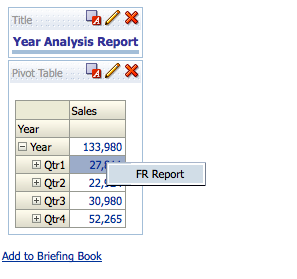 The target FR report is given below. This report also goes against the Demo Basic Essbase cube with Year dimension acting as a User POV.
The target FR report is given below. This report also goes against the Demo Basic Essbase cube with Year dimension acting as a User POV.
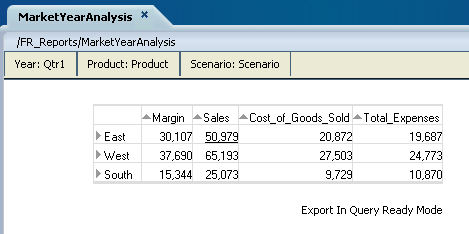 To enable the integration, we need to first setup the ability in BI EE to navigate the EPM catalog. This is done by adding a registry entry in the ActionFrameworkConfig.xml file. This file can be found under {Middleware_Home}\user_projects\domains\bifoundation_domain\config\fmwconfig\biinstances\coreapplication. Open this file in a text editor and add the following XML registry tags
To enable the integration, we need to first setup the ability in BI EE to navigate the EPM catalog. This is done by adding a registry entry in the ActionFrameworkConfig.xml file. This file can be found under {Middleware_Home}\user_projects\domains\bifoundation_domain\config\fmwconfig\biinstances\coreapplication. Open this file in a text editor and add the following XML registry tags
<registry> <id>HDPreg</id> <name>Hyperion Directory Provider</name> <content-type>epm</content-type> <provider-class>oracle.bi.action.registry.epm.HDPRegistry</provider-class> <description>Hyperion Financial Reports Registry</description> <location> <path>http://venkatepm:19000/raframework/browse/listxml</path> </location> <service-access> <account>EPM</account> <propagateIdentity>false</propagateIdentity> </service-access> </registry>
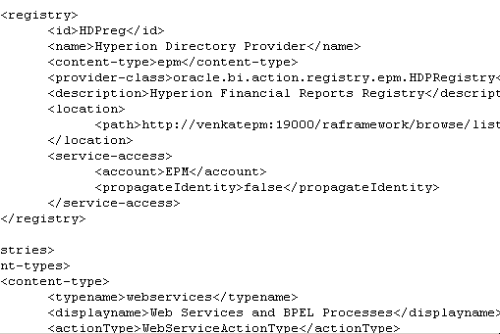 Remember the PropagateIdentity statement determines how the authentication/authorization is done. This is a must and without this tag, the EPM navigation will not work. Also note down the path of the EPM catalog listxml. In EPM 11.1.2, the listxml url has changed to point to the RA Framework. Ensure that while installing EPM, RA Framework is also chosen.
Remember the PropagateIdentity statement determines how the authentication/authorization is done. This is a must and without this tag, the EPM navigation will not work. Also note down the path of the EPM catalog listxml. In EPM 11.1.2, the listxml url has changed to point to the RA Framework. Ensure that while installing EPM, RA Framework is also chosen.
In the above registry XML entry, you will notice that we are using an account called EPM. This is nothing but a pointer to an actual account in the Weblogic Credential framework. So, we need to navigate to the Credentials page in the BI EE FMW Control (http://localhost:7001/em) and setup the EPM account.
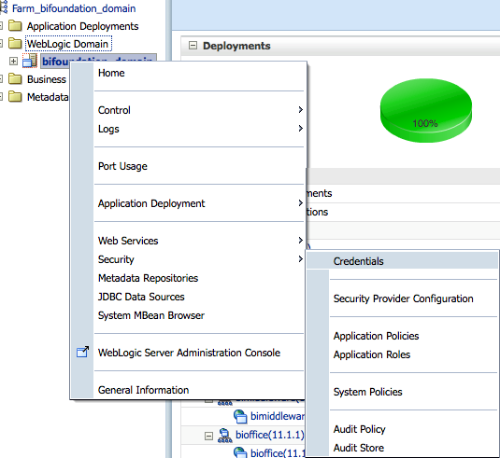 In the Credentials page, create a new Credential Map called oracle.bi.actions (if it does not exist already).
In the Credentials page, create a new Credential Map called oracle.bi.actions (if it does not exist already).
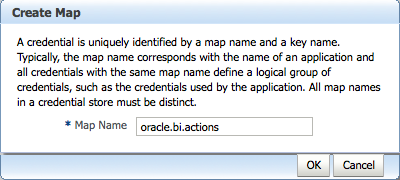 Within this Credential Map, create a new key called EPM. In the username and password section of the EPM key, enter the admin username and password that will be used to connect to the EPM catalog(in my case hyperion/welcome123). This username and password will be used only for the catalog navigation.
Within this Credential Map, create a new key called EPM. In the username and password section of the EPM key, enter the admin username and password that will be used to connect to the EPM catalog(in my case hyperion/welcome123). This username and password will be used only for the catalog navigation.
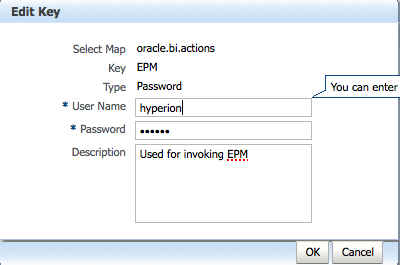
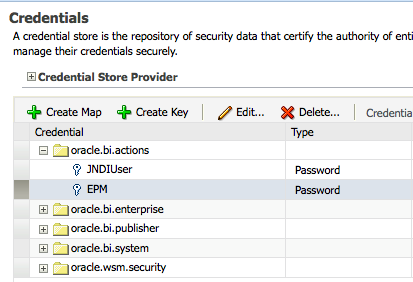 Now restart the entire managed server so that BI EE can pick up the changes. As you see, the entire process of integration between EPM and BI EE (from BI EE) has been made simpler and also now we can add as many registry entries as we want, depending on the number of EPM targets that we want to navigate to.
Now restart the entire managed server so that BI EE can pick up the changes. As you see, the entire process of integration between EPM and BI EE (from BI EE) has been made simpler and also now we can add as many registry entries as we want, depending on the number of EPM targets that we want to navigate to.
After the restart, create a new BI EE report as shown below
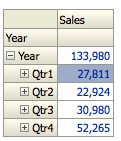 Go to the column properties of the Sales measure and add an Action Link navigation.
Go to the column properties of the Sales measure and add an Action Link navigation.
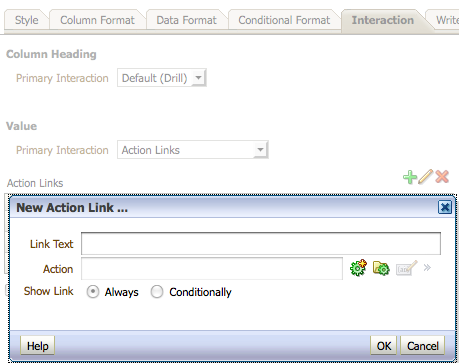 Create a new Action Link and choose Navigate to EPM content as the target.
Create a new Action Link and choose Navigate to EPM content as the target.
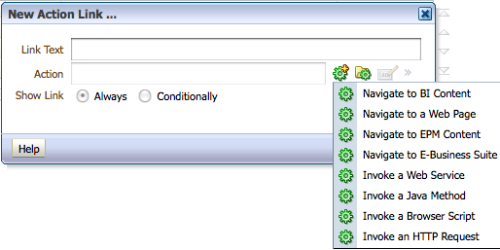 This will basically open up the EPM catalog. Lets choose our target FR report.
This will basically open up the EPM catalog. Lets choose our target FR report.
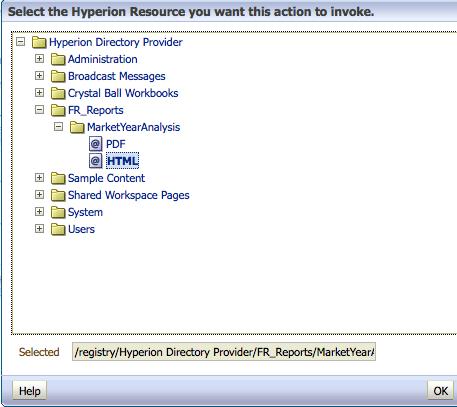 This will automatically open up a parameter screen where most of the workspace specific parameters will be filled in automatically
This will automatically open up a parameter screen where most of the workspace specific parameters will be filled in automatically
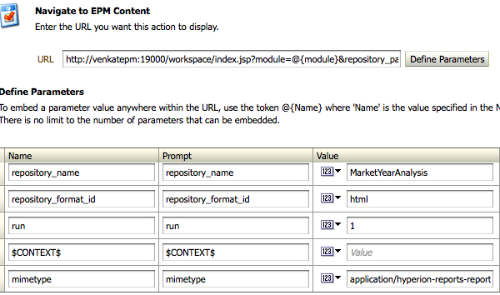 Add a new Parameter called Year which is what we will be passing from BI EE to HFR. Make the Year value to be passed from the Year column
Add a new Parameter called Year which is what we will be passing from BI EE to HFR. Make the Year value to be passed from the Year column
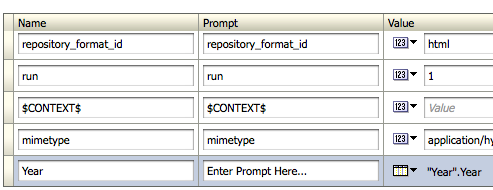 In the URL field, enter the URL given below
In the URL field, enter the URL given below
http://venkatepm:19000/workspace/index.jsp?module=@{module}&repository_path=@{repository_path}&elementType=@{elementType}&repository_name=@{repository_name}&repository_format_id=@{repository_format_id}&run=@{run}&attribute=Year.id.@{Year}&attribute=Product.id.Product&attribute=Accounts.id.Accounts&attribute=Scenario.id.Scenario&attribute=Market.id.Market&mimetype=@{mimetype}
Basically the CONTEXT values can be made to be passed automatically from BI EE to HFR by setting up the dimension mapping in the FR.properties file(we shall see how this works in a future blog entry). But in our case above, we are passing the parameters manually.
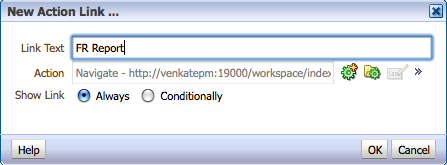 Now we should have the action link enabled on the Sales column. By clicking on the FR Report link, the parameters will get passed from BI EE to HFR automatically. With the above approach, there is no SSO between BI EE and EPM. So, the username and passwords will have to be entered again.
Now we should have the action link enabled on the Sales column. By clicking on the FR Report link, the parameters will get passed from BI EE to HFR automatically. With the above approach, there is no SSO between BI EE and EPM. So, the username and passwords will have to be entered again.
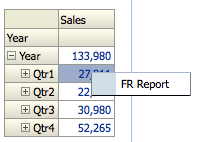
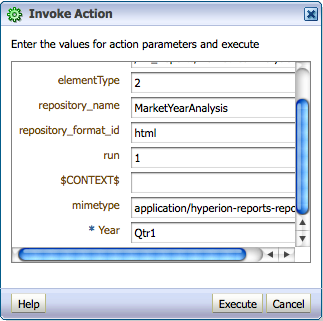 If the SSO is enabled, SSO_TOKEN can be passed across BI EE and EPM so that the navigation is seamless.
If the SSO is enabled, SSO_TOKEN can be passed across BI EE and EPM so that the navigation is seamless.
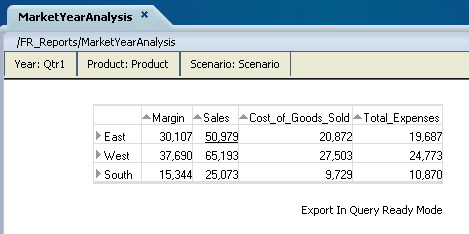 As you see, the Qtr1 value that was passed from BI EE has now set the context in FR. The same can be done for Planning forms, Web Analysis reports etc. I will cover the Planning forms integration with BI EE in a future post.
As you see, the Qtr1 value that was passed from BI EE has now set the context in FR. The same can be done for Planning forms, Web Analysis reports etc. I will cover the Planning forms integration with BI EE in a future post.